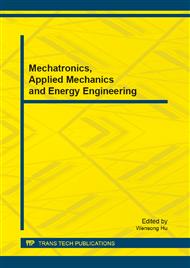[1]
Eric N. Mortensen, William A. Barrett: Interactive Segmentation with Intelligent Scissors, Graphical Models and Image Processing, vol. 60, no. 5 (1998), pp.349-384.
DOI: 10.1006/gmip.1998.0480
Google Scholar
[2]
Markus Hadwiger, Laura Fritz, Christof Rezk-Salama, Thomas Hollt, Georg Geier, and Thomas Pabel: Interactive Volume Exploration for Feature Detection and Quantication in industrial CT Data, IEEE Transactions on Visualization and Computer Graphics, vol. 14, no. 6(2008).
DOI: 10.1109/tvcg.2008.147
Google Scholar
[3]
Yuri Boykov, Marie Jolly: Interactive Graph Cuts for Optimal Boundary & Region Segmentation of Objects in N-D Images, in International Conference on Computer Vision (ICCV), vol. 1(2001), pp.105-112.
DOI: 10.1109/iccv.2001.937505
Google Scholar
[4]
Vladimir Vezhnevets and Vadim Konouchine: GrowCut, -interactive multi-label N-D image segmentation by cellular automata, in Proceedings of Graphicon(2005), pp.150-156.
Google Scholar
[5]
F. Meyer, S. Beucher: Morphological segmentation, Journal of Visual Communication and Image Representation, vol. 1, no. 1(1990), pp.21-46.
DOI: 10.1016/1047-3203(90)90014-m
Google Scholar
[6]
P. Felzensz walb, D. Huttenlocher: Efficient graph-based image segmentation, International Journal of Computer Vision, vol. 59, no. 2(2004), pp.167-181.
DOI: 10.1023/b:visi.0000022288.19776.77
Google Scholar
[7]
M. Kass, A. Witkin, D. Terzopoulos: Snake, active contour models, International Journal of Computer Vision, vol. 1, no. 4(1987), pp.321-331.
DOI: 10.1007/bf00133570
Google Scholar
[8]
D. Comaniciu and P. Meer: Meanshift: a robust approach toward feature space analysis, IEEE Trans. Pattern Anal. Mach. Intell., vol. 24, no. 5(2002), pp.603-619.
DOI: 10.1109/34.1000236
Google Scholar
[9]
Jifeng N., Lei Z., David Z. and Chengke W. : Interactive image segmentation by maximal similarity based region merging, Pattern Recognition, vol. 43(2010), pp.445-456.
DOI: 10.1016/j.patcog.2009.03.004
Google Scholar
[10]
Yonghui G., Jie Y., Xian X. and Feng S. : Efficient cellular automaton segmentation supervised by pyramid on medical volumetric data and real time implementation with graphics processing unit, Expert Systems with Applications, vol. 38, no. 6(2011).
DOI: 10.1016/j.eswa.2010.12.049
Google Scholar
[11]
G. B. Ermentrout and L. Edelstein-Keshet: Cellular automata approaches to biological modeling, Journal of Theoretical Biology, vol. 160(1993), pp.97-133.
DOI: 10.1006/jtbi.1993.1007
Google Scholar
[12]
Q. Yang, C. Wang, X. Tang, M. Chen, Z. Ye: Progressive cut, an image cutout algorithm that models user intentions, IEEE Multimedia, vol. 14, no. 3(2007), pp.56-66.
DOI: 10.1109/mmul.2007.60
Google Scholar
[13]
Y. Li, J. Sun, C. Tang, H. Shum: Lazy snapping, SIGGRAPH, vol. 23(2004), pp.303-308.
Google Scholar
[14]
D. Comaniciu, V. Ramesh and P. Meer: Kernel-based object tracking, IEEE Trans. Pattern Anal. Mach. Intell., vol. 25, no. 5(2003), pp.564-577.
DOI: 10.1109/tpami.2003.1195991
Google Scholar
[15]
Claude K. and N. Piché: Seeded ND medical image segmentation by cellular automaton on GPU, International Journal of Computer Assisted Radiology and Surgery, vol. 24, no. 5(2009), pp.1861-6410.
DOI: 10.1007/s11548-009-0392-0
Google Scholar


